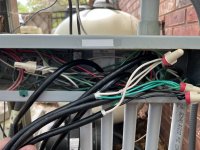We had some new pool lights installed, Pentair IntelliBrite 5G colored LED. At the time our pool guy that installed that said there was an issue fitting the cable and running it to the panel, so he said he removed the ground wire to run it. I immediately questioned this for many reasons, safety being the first but also losing warranty. I had a friend electrician tell him no you can’t do that, so the pool guy separately ran a ground wire.
My question is, is this safe at all? Attached pictures, it looks like the ground wire is just hanging out by itself. Would the wire even survive over time in chemical water, or is there a change of the wire covering eroding away?
Any help would be greatly appreciated.
My question is, is this safe at all? Attached pictures, it looks like the ground wire is just hanging out by itself. Would the wire even survive over time in chemical water, or is there a change of the wire covering eroding away?
Any help would be greatly appreciated.












